A mini C-arm can literally run circles around a full-size C-arm, as if the fixed model was standing still, which, of course, it is.
Mini C-arms don't require a fixed residency in a dedicated room, so you can easily roll them into the OR for on-the-go, on-demand intraoperative imaging. Now, a mini C-arm can't do all the things a fixed C-arm can do. Mini Cs are designed especially for extremity imaging — hands, feet, ankles, wrists, knees, elbows — not to image the torso or the thigh of a 5-foot-5, 350-pound patient. With their smaller arcs and lower power dose, mini Cs can't accomodate or penetrate dense anatomy. Here's what else you should you know about portable fluoroscopes:
- Cost. Mini C-arms generally cost between $60,000 and $90,000. But those aren't the only costs you need to consider. What accessories will you need, and how much will they cost? Accessories could be a laser light, a stand for an accompanying remote control or tablet, wireless foot pedals and so on. How much will service cost? Will you need to upgrade your network or electrical system? Do your surgeons want a printer, USB storage, a CD burner? As with all capital purchases, ask around, and get references from your sales reps to see what other facilities think of each machine you're considering.
- Flat-panel detector or image intensifier? Most mini C-arms are equipped with a flat-panel detector (FPD), which produces much better images than the previous generation of products that featured CCD cameras, known as "X-ray image intensifiers." While more expensive than CCD, flat-panel technology produces a larger field of vision and eliminates distortion; you retain true resolution and clarity even when you magnify the image. Another FPD benefit: They don't hinder the surgeon's access to the patient (surgeons typically must move around a large, bulky image intensifier).
- Positioning. Horizontal, vertical, swivel movements — what is the mini C capable of doing to image hard-to-reach areas? How intricately can you adjust the C-arm's position? You can look at specs, but your clinicians should get to know the C-arm's positioning capabilities intimately during a demo or trial.
- Ease of use. This is vital. Will the machine facilitate better outcomes and reduce surgical time? In other words, how will a particular mini C-arm fit into your workflow? That goes for everyone's workflow — surgeons, nurses, techs, radiographers. You want a system that's intuitive. How many button pushes does it take to do something? On one device, it might take 10; on another, just 2. Get feedback from your radiographer on how easy or difficult the machine is to use during the trialing.
- Trialing. Most vendors will happily give you a week or more to try out their mini C-arms. With this kind of product, consult your surgeons and radiographers. How does it fit in their hands? How's the image quality, the user interface? What did they think about the operation and features? Be careful though, especially if you have rotating techs or people who are not surgical specialists. Don't make a decision based on what your techs or radiographers are comfortable with, because it's evolving all the time. Often, when you ask a radiographer what they want to use, they'll say, "What I've always used." A skilled radiographer could master any mini C-arm in a couple days.
- Electrical issues. Here's something even some vendor reps forget to consider: Is your OR's electrical system capable of accommodating a mini C-arm? Does your OR meet the power requirements? But there's another factor to think about: the "cleanliness" of your power. Are there fluctuations in voltage when the AC or an autoclave turns on, or when all the lights are on? Drops and spikes in voltage can cause problems with your mini C-arm's performance. I've seen it become a big problem.
- Cooling. Simply put, you do not want your mini C-arm to overheat during a procedure. If you're performing very demanding, longer procedures, this is a particularly important aspect of any product. These systems need to have sufficient cooling capabilities; some do, some don't. Demand to see a product's specifications to find out.
- Image storage. You'll be taking a good amount of pictures and video with your mini C-arm. Where are you going to store them? The first thing you should examine is how many images you can store on the device itself. Could you store a week's worth, a month's worth, a year's worth? Originally, mini C-arms could write to CDs, but like the rest of the computing world, there's been a strong move away from CD to USB storage. If you're going to be sending images to PACS after every case, or you just want to print images, storage capacity on the C-arm itself is not much of a concern. The last thing you want to do is lose critical data. I've seen customers compromise by not spending the additional money on onboard storage because they want a super high-end mini C-arm.
- Networking and integration. Will you be sending images from the mini C-arm over your network to PACS, either wirelessly or hard-wired? Do you have the bandwidth and connectivity necessary to achieve that, or will you need to upgrade? Does the C-arm integrate well with your network? Find out.
- Service. These products are rugged and tough, but they need TLC, too. I'd say on average they last 5 to 7 years, but I've seen perfectly operational C-arms in the field that are 15 years old or more. You want to keep the devices well-maintained, with preventive maintenance performed at least once a year. You also want a reliable partner for when things go awry. This is where different vendors set themselves apart in terms of responsiveness and reliability. Beyond the standard manufacturer warranty, I'd recommend purchasing at least 5 years of additional service that picks up after the warranty expires. You can negotiate much better pricing for extended service if you do that up front. OSM
GE Healthcare
OEC One CFD
gehealthcare.com
866-281-7545
Price: not provided
FYI: This product's image chain delivers 1:1 image detail from a CMOS flat-panel detector to a connected 4K 27-inch monitor that's adjustable through 5 ranges of motion to the surgeon's line of sight. The attached touch panel for the assisting clinician also displays the image, while offering control over advanced features, including a live 4x zoom that lets surgeons view more anatomy without employing magnification modes; the image can also be rotated using the touch panel. Surgeons can review the most recent fluoro sequence using a DVR-like replay feature. When moving the C-arm between rooms, its 5-minute standby power protects against patient data loss. The system, which can save up to 150,000 images, is capable of numerous procedure settings for orthopedic, spine, general surgery, urology, pain management and vascular.
Hologic
Fluoroscan InSight FD
fluoroscan.com
800-321-4659
Price: $65,000 to $85,000
FYI: A rotating flat detector increases imaging versatility for long bones while minimizing radiation by preventing patient and surgeon exposure to the detector's unused area. It features a tilting, pivoting 24-inch HD touchscreen with directly mounted keyboard. Its low-dose option reduces dose rates by over 50% while still, according to the company, providing clinically equivalent images. Clinicians can optionally expand image size by 50%. The vendor says it's improved its previous product by simplifying the method for locking the C-arm, reducing the system's total width in the locked position and thus saving OR space. Other new features include pinch-to-zoom on the touchscreen, save notifications that let users identify saved images and the ability to filter for saved images.
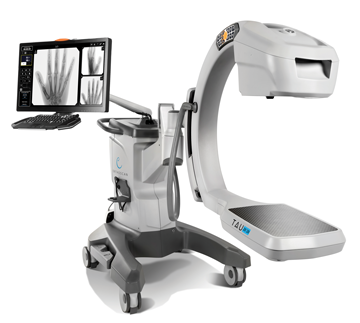
Orthoscan
TAU 2020
orthoscan.com
480-503-8010
Price: not provided
FYI: Call this one "Biggie Smalls" if you'd like. Orthoscan's goal here is to "blur the line" between mini and full-size C-arms. The TAU 2020 sports a very large flat-panel detector — 20cm by 20cm — and a 27-inch touchscreen high-definition monitor. Touted as the only mini C-arm indicated for pediatric use, its touchscreen interface includes onscreen help that describes common system functions. The device includes surgical LED lights that eliminate shadows originating from the C-arm and staff. Its stepless, motorized collimator — something usually found in fixed C-arms — can be adjusted through the touchscreen. This device also features pulsed fluoroscopy, another dosage-lowering approach usually found only on full-size C-arms. Other features include a multifunction wireless footswitch, backlit controls, 3-way brake control for easier transport, and integrated cable pushers that protect power cords and other cables from damage. The power button and I/O ports are directly on top of the chassis.
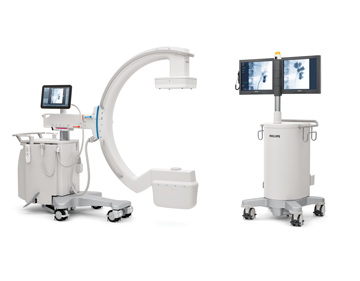
Philips Healthcare
Zenition 70
usa.philips.com/healthcare
800-722-9377
Price: not provided
FYI: The Zenition 70 features some serious digital technology, with integrated tablet/smartphone-like touch-driven apps residing on a Windows platform. Paired with its high-speed wireless data transmission, that provides a lot of useful stuff. You can roll out changes and upgrades to a whole fleet of these C-arms at once, and implement the latest security standards to protect patient data and prevent malware attacks. Your system administrators can perform many system tasks themselves, while Philips can log in on the spot to assist. The company offers a program that lets you receive its latest hardware and software upgrades over time for a predictable fee. Philips also touts the product's intuitive nature, thanks in large part to its point-and-shoot design and on-screen guidance, that it says reduces the time and cost of training and makes the system usable by clinicians at all experience levels. Other features include heat management, application-specific protocols, customizable presets, positioning memory and the ability to draw an outline on an image on the touchscreen using a stylus pen.
Siemens Medical
Cios Alpha
siemens-healthineers.com
610-415-8133
Price: not provided
FYI: Siemens says this high-definition 2D mobile C-arm leverages the Retina technology seen in high-end smartphones to deliver optimal image quality, while its Combined Applications to Reduce Exposure (CARE) technologies determine the proper dose for each case. The system's intelligent power management system includes an energy storage unit and active cooling to prevent overheating while maintaining power. Its anti-microbial surface and washable mouse make cleaning and disinfection as easy as possible, says the company. Features include dedicated exam sets, dose buttons, smart collimation and a laser light localizer.
Turner Imaging Systems
Smart-C
turnerxray.com
866-870-2022
Price: $75,000 for base unit
FYI: There's mini, and then there's mini. That's what Turner says about this battery-operated C-arm, which at 16 pounds is very light but nonetheless can perform full high-definition fluoroscopic and radiological imaging on location. A clinician can literally carry the wireless system by hand to wherever it's needed. The C-arm itself is collapsible, and it features a detachable, independent articulating arm for optimal positioning, as well as an independent monitor cart or optional support stand. You can even use it on a tabletop. The company touts the device's 15x15 flat panel detector's thinness as well. The system includes a 27-inch touchscreen HD monitor, a 13-inch tablet that receives images wirelessly, along with a keyboard and printer. Perhaps the best part? No cabling.
Ziehm Imaging
Solo FD
ziehm.com
800-503-4952
Price: not provided
FYI: The Solo FD is promoted as having the smallest footprint on the market. Its integrated intelligent heat management feature automatically reduces pulse frequency in the event of a temperature increase. Wireless is a big deal with this product, as its wireless footswitch can initiate an X-ray, while images can be sent to PACS or wall- or ceiling-mounted monitors wirelessly. The interface of the touchscreen, based on an open, modular software architecture, can be upgraded and expanded with additional software modules without the need for hardware changes. It comes integrated with a 19-inch dual flat-screen monitor mounted on an articulating monitor arm; a 24-inch landscape split-screen monitor is also available.
.svg?sfvrsn=be606e78_3)
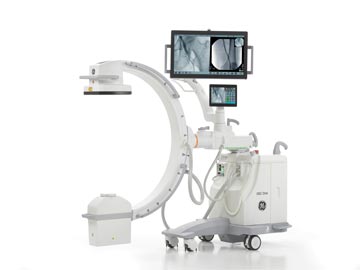
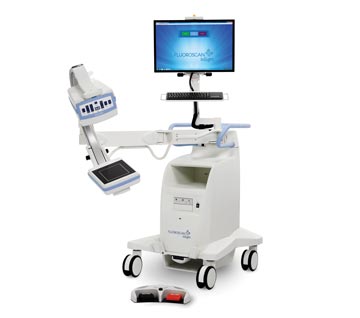


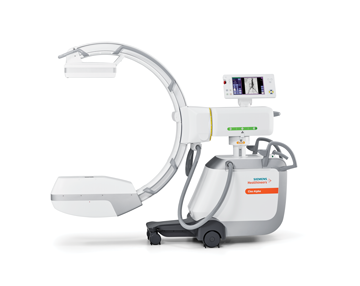
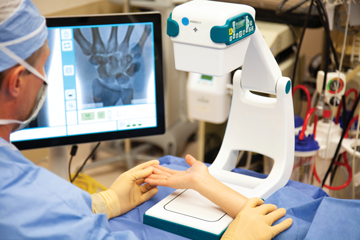
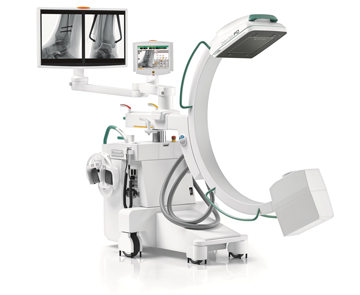
.svg?sfvrsn=56b2f850_5)